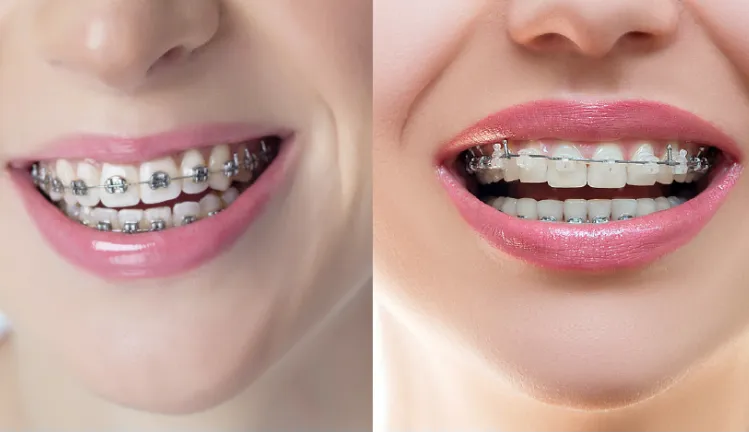
Tabla de contenido
- Entendiendo los aparatos de ortodoncia
- Brackets metálicos tradicionales: la opción clásica
- Brackets de cerámica: la alternativa sutil
- Comparación de aparatos de ortodoncia: rendimiento y eficiencia
- Brackets transparentes vs. brackets tradicionales: Comparación estética
- Funcionalidad y eficacia: Comparación de aparatos de ortodoncia
- Consideraciones de costos: Cómo presupuestar sus aparatos ortopédicos
- Mantenimiento e higiene: Cómo mantener limpios los brackets
- ¿Qué aparatos son mejores?
- Escenarios del mundo real
- Reflexiones finales: Cómo elegir los aparatos adecuados para su sonrisa
- Preguntas frecuentes
La alineación de los dientes sigue siendo una de las consultas de ortodoncia más buscadas en línea, comparando los aparatos de cerámica vs. brackets metálicos. Tanto los brackets cerámicos como los metálicos funcionan para corregir dientes desalineados, abordando problemas de mordida y Mejorando la salud dental.
Sin embargo, difieren en cuanto a los materiales utilizados, la apariencia, la durabilidad, el precio y la idoneidad. En este detallado... Comparación, exploramos todo, desde los brackets transparentes versus los tradicionales hasta las ventajas y beneficios de Brackets de cerámica para que puedas hacer una elección segura y acertada.
Entendiendo los aparatos de ortodoncia
Los aparatos de ortodoncia son aparatos dentales diseñados para enderezar y alinear los dientes, corregir problemas de mordida y mejorar Salud bucal general. Funcionan aplicando una presión suave y constante sobre los dientes a lo largo del tiempo, guiándolos gradualmente. en la posición deseada. Los aparatos ortopédicos han formado parte del cuidado dental durante más de un siglo, evolucionando desde rudimentarios bandas de metal a los sofisticados sistemas que tenemos hoy.
Mucha gente se pregunta: "¿Se puede comer con brackets?". Los brackets modernos constan de varios componentes clave: brackets (unidos a cada diente), arcos de alambre (que conectan los brackets), ligaduras (pequeñas bandas que sujetan los alambres en su lugar) y A veces, se usan bandas elásticas para ajustar la mordida. Estos elementos contribuyen a crear movimiento en la mandíbula y los dientes.
Los aparatos más utilizados en la actualidad se dividen en dos categorías principales: aparatos metálicos tradicionales y aparatos de cerámica, cada uno con sus propias características únicas. Elegir entre ellas puede afectar significativamente su ortodoncia. experiencia, especialmente en términos de estética, comodidad y conveniencia.
Brackets metálicos tradicionales: la opción clásica

Los brackets metálicos han sido durante mucho tiempo la solución predilecta para el tratamiento de ortodoncia. Fabricados con acero inoxidable de alta calidad o Estos aparatos, fabricados con níquel-titanio, son conocidos por su resistencia y durabilidad. Pueden corregir una amplia gama de problemas dentales. problemas, incluyendo desalineaciones graves, apiñamiento y problemas de mordida. Gracias a los avances en odontología Tecnología, los brackets metálicos modernos son más pequeños, elegantes y cómodos que nunca. Hablemos del metal. Pros y contras de los brackets.
Beneficios de los brackets metálicos
- Altamente duradero : ideal para casos de ortodoncia complejos.
- Rentable : Generalmente más asequible y a menudo cubierto por el seguro.
- Tiempo de tratamiento eficiente : Resultados más rápidos en muchos casos.
- Personalizable : elige bandas de colores para personalizar tu look.
Desventajas de los brackets metálicos
- Altamente visible : no es ideal para quienes se preocupan por la estética.
- Molestias iniciales : Los brackets pueden irritar las mejillas y los labios al principio.
- Menos discreto : puede no ser adecuado para profesionales o personas preocupadas por su imagen.
A pesar de estos inconvenientes, los brackets metálicos siguen siendo una opción probada y muy eficaz para quienes priorizan Resistencia y asequibilidad.
Brackets de cerámica: la alternativa sutil

Los brackets de cerámica para adultos cumplen la misma función que los brackets metálicos, pero utilizan brackets transparentes o del color del diente que se combinan De forma más natural con tu sonrisa. Especialmente populares entre adolescentes y adultos, estos brackets ofrecen una sonrisa más discreta. Alternativa al metal: ideal para profesionales o cualquier persona preocupada por la apariencia durante el tratamiento de ortodoncia.
Fabricados con materiales compuestos duraderos, los aparatos de cerámica para adultos pueden mover los dientes con la misma eficacia en la mayoría de los casos. Aunque son un poco más grandes y más propensos a dañarse que los soportes de metal, su baja visibilidad los convierte en un La opción líder en el debate entre brackets transparentes y brackets tradicionales.
Para una solución aún más discreta y flexible, los adultos pueden considerar los alineadores transparentes. Estos alineadores son extraíbles y prácticamente... Las bandejas invisibles brindan tanto estética como comodidad, perfectas para quienes desean una opción de tratamiento que se ajuste a sus necesidades. se integra perfectamente en un estilo de vida ajetreado.
Beneficios de los brackets cerámicos
- Atractivo estético : menos visible en fotografías y entornos sociales.
- Aumenta la confianza : ideal para quienes se encuentran en entornos profesionales o sociales.
- Rendimiento comparable : eficaz para casos de ortodoncia leves a moderados.
Desventajas de los brackets cerámicos
- Más frágiles : los soportes son propensos a agrietarse bajo presión.
- Riesgo de manchas : las correas elásticas pueden decolorarse con ciertos alimentos o bebidas.
- Costo más alto : no siempre está totalmente cubierto por el seguro.
- Posible tratamiento más prolongado: Debido a la fragilidad y fricción de los brackets.
Para quienes se preocupan por la apariencia, estos beneficios estéticos a menudo superan los pequeños inconvenientes.
Comparación de aparatos de ortodoncia: rendimiento y Eficiencia
A continuación se muestra un desglose detallado de cómo se comparan los brackets de cerámica y los de metal:
| Característica | Brackets metálicos | Brackets de cerámica |
|---|---|---|
| Material | Acero inoxidable | Alúmina policristalina |
| Visibilidad | Fácilmente perceptible | Del color del diente o transparente |
| Fortaleza | Acérrimo | Más frágil |
| Tinción | Sin riesgo | Posible si no se limpia bien |
| Comodidad | Puede causar irritación. | Bordes más suaves |
| Tiempo de tratamiento | A menudo más corto | Puede tardar un poco más |
| Costo | Más bajo | Más alto |
Los brackets metálicos tienden a ofrecer resultados más rápidos en casos complejos debido a su durabilidad y menor riesgo de brackets. rotura.
Brackets transparentes vs. brackets tradicionales: Comparación estética
La mayor diferencia a menudo se reduce a cómo se ven los brackets. Los brackets metálicos son fáciles de detectar, lo que puede hacer que algunos pacientes cohibidos. Los brackets cerámicos, por otro lado, están diseñados para ser lo más discretos posible, especialmente desde una distancia conversacional o en fotografías.
Los adultos, en particular, tienden a evitar la apariencia de "boca de metal". Los brackets de cerámica ofrecen una solución equilibrada. Combinando un rendimiento confiable con una apariencia más discreta y estéticamente agradable.
No son invisibles; de cerca, siguen siendo visibles, y sus ligaduras elásticas pueden manchar. Pero su visión... La ventaja es innegable para cualquiera que quiera sentirse seguro durante el tratamiento.
Funcionalidad y eficacia: Ortodoncia Comparación de brackets
Tanto los aparatos de cerámica como los de metal están diseñados para enderezar los dientes y corregir problemas de mordida, aunque los aparatos de metal generalmente... Funcionan mejor en casos de ortodoncia más complejos o severos. Su resistencia permite a los ortodoncistas aplicar más presión y realizar ajustes más rápidos y agresivos.
Los brackets de cerámica son eficaces para la mayoría de los problemas leves a moderados, pero pueden requerir plazos más largos debido a su mayor materiales delicados.
Finalmente, su ortodoncista evaluará su condición para ver si los aparatos de cerámica pueden ofrecer los mismos resultados. o si el metal es más apropiado.
Consideraciones de costos: Cómo presupuestar sus aparatos ortopédicos
Los aparatos metálicos suelen ser más económicos y cuestan entre $3,000 y $7,000 dependiendo de la complejidad del caso, la ubicación, y seguros.
Los brackets de cerámica cuestan más, entre $4,000 y $8,000, debido a los materiales y la estética. Los brackets de cerámica también pueden ser más caros. propensos a sufrir daños, lo que podría dar lugar a reparaciones adicionales y costos generales más elevados.
Consulte con su aseguradora para saber qué cubre. Algunos planes clasifican los brackets cerámicos como cosméticos. ofreciendo menos reembolso.
Mantenimiento e higiene: Cómo mantener limpios los brackets
Independientemente del tipo, los brackets requieren un cuidado constante. Necesitará usar herramientas de limpieza, como un cepillo y usar hilo dental, para evitar manchas y acumulación de placa.
Los brackets de cerámica requieren atención especial. Si bien los brackets son resistentes a las manchas, las ligaduras elásticas no. Si te encanta el café, Con vino o curry, tenga cuidado. Usar pajitas y enjuagarse después de las comidas ayuda a conservar su aspecto.
Los brackets metálicos no se manchan, pero pueden atrapar alimentos, por lo que una limpieza exhaustiva es esencial para evitar problemas en las encías.
¿Qué aparatos son mejores?
Depende de tus necesidades, prioridades y presupuesto .
Elija aparatos metálicos si:
- Necesita corrección para un problema complejo
- Son conscientes del presupuesto
- No te preocupes por la visibilidad
- ¿Quieres una fiabilidad comprobada?
Elija brackets de cerámica si:
- Valora un look más discreto
- ¿Es un profesional que trabaja o un adolescente preocupado por su imagen?
- Tengo un caso leve a moderado.
- Estamos comprometidos con una excelente higiene.
Escenarios del mundo real
- Sarah , una experta en marketing de 30 años, eligió aparatos de cerámica para mantener una imagen impecable. El tratamiento tardó un poco más, pero le encantó lo imperceptibles que eran.
- Jake , de 14 años, optó por los brackets metálicos. No le importaba el aspecto y le gustaba personalizarlos. con bandas de colores.
- Emma , una estudiante universitaria con una sobremordida leve, eligió aparatos de cerámica después de hablar con su Ortodoncista, discreto y eficaz.
Reflexiones finales: Cómo elegir los aparatos ortopédicos adecuados para usted Sonrisa
Decidir entre aparatos de cerámica y de metal puede resultar abrumador, pero conocer las ventajas, desventajas y costos de cada uno hace que sea más fácil decidir. Su decisión es más fácil. Los brackets metálicos son resistentes, económicos y rápidos, ideales para necesidades más complejas. Los brackets cerámicos... Ofrecen discreción y comodidad, especialmente para adultos o cualquier persona que desee una solución más sutil.
Sea cual sea su elección, la ortodoncia es un compromiso a corto plazo con beneficios a largo plazo. Con la orientación de expertos y el tratamiento adecuado... Con cuidado, usted se irá con una sonrisa saludable y segura que durará toda la vida.
Preguntas frecuentes
1. ¿Qué son mejores, los brackets de cerámica o los de metal?
Depende de tus necesidades, los brackets metálicos son más fuertes y rápidos, mientras que los brackets cerámicos son más discreto y estético.
2. ¿Cuál es la diferencia entre el metal y la cerámica?
Los brackets metálicos utilizan brackets de acero inoxidable; los brackets de cerámica utilizan brackets del color del diente o transparentes. para una apariencia menos visible.
3. ¿Cuál es la diferencia entre los brackets cerámicos y los estándar?
Los brackets de cerámica son un tipo de brackets estándar pero utilizan brackets transparentes o del color del diente en lugar de metal para una apariencia más sutil.
4. ¿Son más rápidos los brackets metálicos o cerámicos?
Los aparatos metálicos suelen funcionar más rápido debido a su durabilidad y resistencia a las roturas.
Citas:
Referencias
Alassiry, A., y Alqahtani, M. (2023). Una revisión sobre brackets de ortodoncia y su aplicación en la práctica clínica. Revista de Farmacia y Ciencias Bioafines, 15(2), 389–395. https://doi.org/10.4103/jpbs.jpbs_7_23
Ajith, PM, Shetty, RM, Shetty, S., Prasad, KD y Bhat, NS (2017). Comparación de la resistencia de unión de metales. y brackets cerámicos utilizando primers convencionales y autograbantes: un estudio in vitro. Revista de Farmacia y Ciencias Bioaliadas, 9 (Supl. 1), S83–S87. https://doi.org/10.4103/jpbs.JPBS_171_17
Alsabti, RM, Jubran, A. y Rajab, LD (2024). Comparación clínica de las tasas de fracaso de prótesis metálicas y cerámicas. Brackets: Un estudio de 12 meses. Revista de Odontología Clínica y Experimental, 16(2), e89–e94. https://doi.org/10.4317/jced.60966
Moshkelgosha, V., Sadrhaghighi, HR y Rafighi, A. (2011). Liberación de metales y citotoxicidad de diferentes Sistemas de brackets y alambres de ortodoncia: Un estudio in vitro. Revista de Farmacia y Odontología Clínica, 5(2), 75–81. https://journals.lww.com/jpcd/fulltext/2023/11000/liberación_de_metales_y_citotoxicidad_de_diferentes.5.aspx







